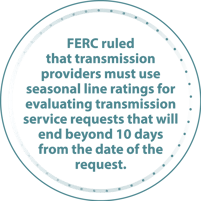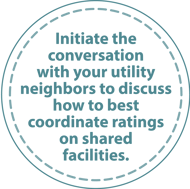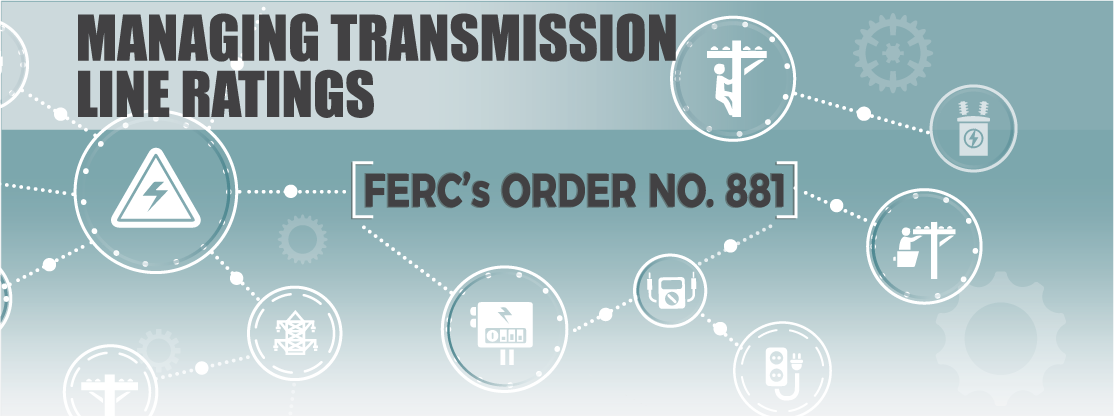- Home
- Services
- Hi-Line Engineering
- About
- Careers
- Contact
- Requests For Proposals
Managing Transmission Line Ratings
by GDS Associates, Inc | May 3, 2022 | Newsletter - TransActions , Transmission
On December 16, 2021, the Federal Energy Regulatory Commission (“FERC”) issued Order No. 881 which finalized its proposed rulemaking from docket RM20-16-000. GDS Associates provided a summary of the proposed rulemaking in an earlier TransActions article and is providing this update with a summary of the final rule, including responsibilities for transmission providers and transmission owners. The final rule was published in the Federal Register on January 13, 2022, with an effective date of March 14, 2022. Transmission providers are required to submit their compliance filings by July 12, 2022, with an implementation deadline no later than July 12, 2025.
Definitions
FERC established the following final definitions for ambient-adjusted and dynamic line ratings:
Ambient-Adjusted Rating (AAR): “a transmission line rating that: (1) applies to a time period of not greater than one hour; (2) reflects an up-to-date forecast of ambient air temperature across the time period to which the rating applies; (3) reflects the absence of solar heating during nighttime periods where the local sunrise/sunset times used to determine daytime and nighttime periods are updated at least monthly, if not more frequently; and (4) is
calculated at least each hour, if not more frequently.”
Dynamic Line Rating (DLR): “a transmission line rating that: (1) applies to a time period of not greater than one hour; and (2) reflects up-to-date forecasts of inputs such as (but not limited to) ambient air temperature, wind, solar heating intensity, transmission line tension, or transmission line sag.”
Requirements for AARs
FERC ruled that transmission providers must use AARs for evaluating transmission service requests for transmission service that will end within the next 10 days. Also, transmission providers must use AARs as the basis for their determination of the necessity of certain curtailment, interruption, or redispatch of transmission service anticipated to occur within those 10 days. Transmission providers must keep seasonal ratings available as the default if the forecast data is not available or there is a communications failure. These short-term ratings will therefore likely deviate from ratings utilized in the system planning process. Transmission Owners are ultimately responsible for developing the AARs.
evaluating transmission service requests for transmission service that will end within the next 10 days. Also, transmission providers must use AARs as the basis for their determination of the necessity of certain curtailment, interruption, or redispatch of transmission service anticipated to occur within those 10 days. Transmission providers must keep seasonal ratings available as the default if the forecast data is not available or there is a communications failure. These short-term ratings will therefore likely deviate from ratings utilized in the system planning process. Transmission Owners are ultimately responsible for developing the AARs.
If the equipment is affected by ambient air temperature, it requires an AAR. If it is not affected by ambient air temperature, an exception can be utilized consistent with good utility practice. AARs must incorporate a set of electrical equipment ratings that collectively operate as a single bulk electric system element (e.g., transformers, relay protective devices, terminal equipment, and series and shunt compensation devices) and that the most limiting component from that set determines the transmission line rating.
Ratings must be provided in a table or database format and cover the range of local historical temperatures +/- 10° Fahrenheit for the area where the equipment is located. Ratings must be provided in increments for every 5 degrees or less, but forecasting margin is allowed consistent with good utility practice.
Requirements for SLRs
FERC ruled that transmission providers must use seasonal line ratings for evaluating transmission service requests that will end beyond 10 days from the date of the request. Similar to AARs, transmission providers must also use seasonal line ratings (SLRs) when determining to curtail, interrupt, or redispatch transmission service beyond the next 10 days. SLRs must utilize at least 4 seasons that “reasonably reflect portions of the year where expected high temperatures are relatively consistent.” Seasonal ratings must be recalculated at least annually using historical temperatures.
Use of Emergency Ratings
Transmission providers must use uniquely determined emergency ratings for contingency analysis in the operations horizon and in post-contingency simulations of constraints. These must incorporate adjustments for ambient air temperature and solar heating impacts and include the amount of time the equipment can operate at the higher current.
Transmission owners are allowed to develop the methodology for emergency ratings, but they must be calculated separately from normal ratings. However, emergency ratings must still consider ambient air temperatures and impacts (or the lack thereof) from solar radiation.
Declining Requirements for DLRs and Studies
FERC declined to mandate DLR implementation like AARs and SLRs but did open a new docket to “further explore” in AD22-5-000.
Exceptions and Alternate Ratings
FERC will allow exceptions to the required AARs and SLRs if the transmission line rating is not affected by ambient air temperature or where a transmission provider an alternate rating is needed to ensure the safety and reliability of the transmission system. Exceptions must be reviewed every 5 years or less to determine whether it should endure.
Requirements for RTOs and ISOs
FERC required RTOs/ISOs to establish and maintain the systems and procedures necessary to allow transmission owners in their regions to electronically update transmission line ratings on at least an hourly basis. TPs must also verify but not audit these ratings. Consistent with the NOPR, RTOs/ISOs must revise their dispatch and unit commitment models to implement AARs for both day ahead and real time markets and any intra-day reliability unit commitment or reliability assessment commitments.
Transparency Enhancements
Public utility transmission owners must share transmission
line ratings and methodologies with their transmission provider(s) and with market monitors in RTOs/ISOs. Transmission providers must share their transmission owners’ transmission line ratings and methodologies with any transmission provider(s) upon request. Transmission providers must maintain a database of their transmission owners’ transmission line ratings and methodologies on the transmission provider’s Open Access Same-Time Information System (OASIS) site or another password-protected website. Transmission providers must post on OASIS or another password-protected website any uses of exceptions or temporary alternate ratings.
WHAT ORDER NO. 881 MEANS FOR TRANSMISSION OWNERS
- More data, equipment, and training. In order to comply with requirements for AAR calculations, additional data on ambient temperature, humidity, wind speed, wind direction and other factors will need to be captured in real-time. This will include field equipment, more granular weather/wind forecasting and modifications to SCADA to provide real time ratings for state estimation and ATC (Available Transfer Capability) calculations. Additional training will also be needed for system operators and operations support staff to ensure AARs are properly monitored in real-time and accounted for in short-term planning studies and curtailment protocols.
- Revised methodologies, processes, and documentation for NERC (North American Electric Reliability Corporation) compliance. Updated rating methodologies need to be documented and should be ready for the July 12, 2022, Compliance Filing to ensure compliance with regional and NERC facility rating standards and FERC guidance from the NOPR. New facility ratings processes will need to be developed for AAR calculations. Other affected documents will include the Capacity Benefit Margin Implementation Document (CBMID) and Transmission Reliability Margin Implementation Document (TRMID). On the operations front, calculation of IROLs/SOLs will need to be reviewed and adjusted, as necessary.
- Open Access Transmission Tariff revisions.
Changes to line ratings inevitably impact the calculation of Available Transmission Capacity/Available Flowgate Capacity (ATC/AFC). The methodology for ATC/CBM/TRM calculation needs to be revised to reflect changes made to the ATCID (Available Transfer Capability Implementation Document), CBMID and TRMID. These changes may also lead to changes to short-term and secondary non-firm transmission service. - OASIS Changes. Depending on the method of automation you choose for calculation and posting of ATC, software enhancements for real-time calculation tools, algebraic decrementing of ATC based on confirmed service, incorporating real-time transmission modeling for ATC values all need to be implemented.
- WEIM, WEIS and SEEM Impacts. These intra-hour energy imbalance markets in the West and Southeast will be impacted by AARs to the extent they either free up or reduce short-term transmission capacity. If DLR changes are implemented at some point, the imbalance markets will certainly feel the pinch.
What Now?
GDS recommends the following steps to be ready for the line rating NOPR and its eventual implementation:
GET IN FRONT OF THE ISSUE: The Compliance Filings are due on July 12, 2022. Participate in various associations such as APPA (American Public Power Association) and NRECA (National Rural Electric Cooperative Association) to learn best practices from others. Read up on Order 881 so you are familiar with what you need to do.
START EVALUATING YOUR CONTRACTS: Begin reviewing your power supply and transmission contracts to understand how any changes to facility ratings impacts short-term deliverability, interconnection rights, transmission service reservations and tagging procedures, and curtailment/force majeure provisions.
START EVALUATING PROCESS CHANGES: Start doing your
research now to look at tools and equipment you will need to implement Order 881. Begin assessing your NERC Standards documentation and OATT (Open Access Transmission Tariffs) processes such as your Facility Rating Methodology, ATCID, CBMID, TRMID, TPL (Transmission Planning) practices and IROL/SOL methodology. Leverage the expertise of your consultants to assist in the transition.
START EVALUATING HARDWARE AND SOFTWARE CHANGES: Talk to your SCADA and OASIS vendors by communicating what you need. Make sure they see Order 881 the way you see it and ask questions when you do not agree.
 COMMUNICATE WITH NEIGHBORS AND WITH THE RTO/ISO: Initiate the conversation with your utility neighbors to discuss how to best coordinate ratings on shared facilities. Be engaged with the RTO/ISO stakeholder processes where the rules will be made and the OATT changes will be discussed.
COMMUNICATE WITH NEIGHBORS AND WITH THE RTO/ISO: Initiate the conversation with your utility neighbors to discuss how to best coordinate ratings on shared facilities. Be engaged with the RTO/ISO stakeholder processes where the rules will be made and the OATT changes will be discussed.
KEEP AN EYE OUT FOR DISCUSSIONS REGARDING IMPLEMENTATION OF ANYTHING RELATED TO DYNAMIC LINE RATINGS: FERC is certainly not done with this issue. GDS will also be tracking this and will be ready to assist with any regulatory filings or technical assessments when the time comes.
For more information or to comment on this article, please contact:
 John Chiles, Principal
John Chiles, Principal
GDS Associates, Inc. - Marietta, GA
770-799-2423
 Paul Kelly, Managing Director
Paul Kelly, Managing Director
GDS Associates, Inc. - Marietta, GA
770-799-2359
GET OUR NEWSLETTER
RECENT POSTS
- Why MOD-026-2 Matters: Raising the Bar for Generator and IBR Modeling Reliability
- Exploring the 2026-2028 Reliability Standards Development Plan
- Blackstart Resource Availability During Extreme Cold Weather Conditions
- DOE Pushes FERC to Accelerate Large Load Grid Access
- Building a Cyber-Aware Workforce in the Utility Sector
Archives
- December 2015 (8)
- June 2025 (7)
- January 2016 (6)
- July 2016 (6)
- March 2021 (6)
- May 2022 (6)
- August 2020 (5)
- March 2015 (4)
- January 2019 (4)
- June 2019 (4)
- August 2019 (4)
- February 2020 (4)
- May 2020 (4)
- June 2020 (4)
- December 2020 (4)
- July 2021 (4)
- October 2021 (4)
- April 2024 (4)
- December 2024 (4)
- May 2025 (4)
- April 2015 (3)
- August 2016 (3)
- February 2017 (3)
- July 2017 (3)
- February 2018 (3)
- February 2019 (3)
- November 2019 (3)
- March 2020 (3)
- April 2020 (3)
- September 2021 (3)
- December 2021 (3)
- August 2022 (3)
- December 2022 (3)
- April 2023 (3)
- July 2023 (3)
- December 2023 (3)
- September 2024 (3)
- October 2025 (3)
- December 2025 (3)
- May 2014 (2)
- February 2016 (2)
- March 2016 (2)
- September 2016 (2)
- November 2016 (2)
- January 2017 (2)
- July 2018 (2)
- November 2018 (2)
- March 2019 (2)
- May 2019 (2)
- July 2020 (2)
- September 2020 (2)
- April 2021 (2)
- August 2021 (2)
- October 2024 (2)
- September 2025 (2)
- February 2014 (1)
- April 2014 (1)
- July 2014 (1)
- August 2014 (1)
- November 2014 (1)
- February 2015 (1)
- May 2015 (1)
- June 2015 (1)
- November 2015 (1)
- October 2016 (1)
- December 2016 (1)
- October 2018 (1)
- December 2018 (1)
- April 2019 (1)
- July 2019 (1)
- September 2019 (1)
- October 2020 (1)
- November 2020 (1)
- February 2021 (1)
- April 2022 (1)
- July 2022 (1)
- October 2022 (1)
- August 2023 (1)
- October 2023 (1)
- July 2025 (1)
- November 2025 (1)
Categories
- Newsletter - TransActions (85)
- News (78)
- Employee Spotlight (35)
- Energy Use & Efficiency (28)
- Energy, Reliability, and Security (17)
- Other Specialized Services (11)
- Environment & Safety (10)
- Power Supply (8)
- Transmission (8)
- NERC (7)
- Utility Rates (7)
- Cyber Security (5)
- Energy Supply (4)
- Hi-Line: Utility Distribution Services (4)
- Battery Energy Storage (3)
- Uncategorized (2)
- Agriculture (1)
- Hi-Line: Seminars & Testing (1)
